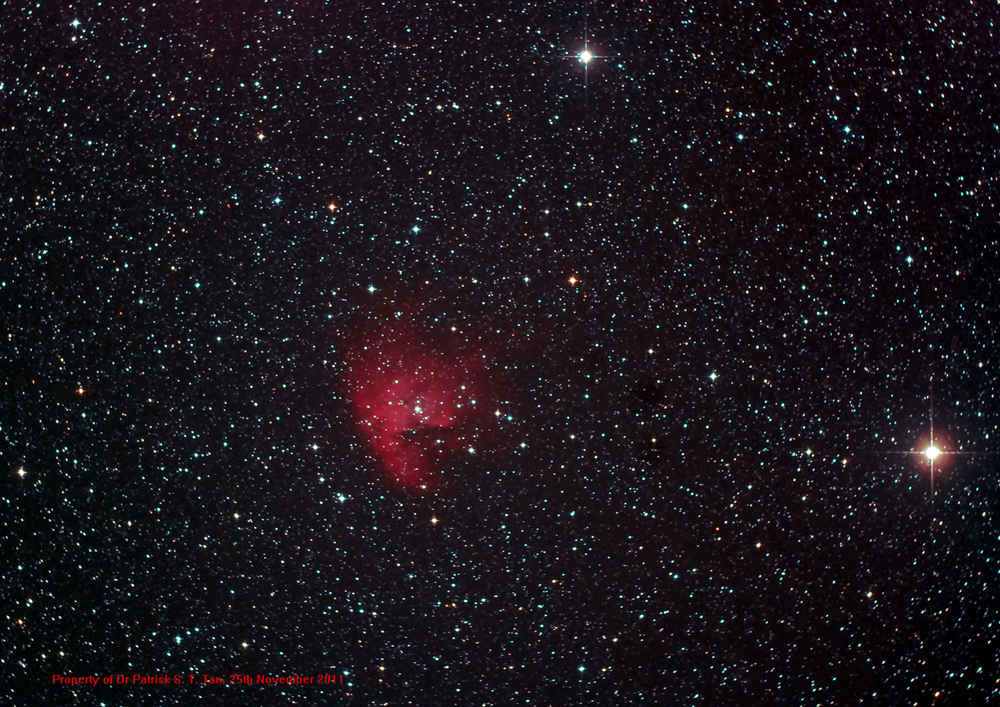
NGC 281: Pacman Nebula
Date: 25/11/11 Time: 2125hrs Location: Sunningwell Temperature: 7.4ºC Relative Humidity: 64%
Camera: Nikon D80 Scope: William Optics Z66 Apo Doublet at prime focus Field-flattener: William Optics VIII 0.8x focal reducer Mount: piggy-backed on Meade LX90 in equatorial mode Filter: Astronomik CLS (LPF broadband filter) Exposures: 6 x 10 minutes + 1 x 5 minutes ISO: 1600 F ratio: 5.9 Guidance: Autoguided
New moon on a Friday night - the sky was supposed to be clear but transparency and seeing were both poor. Very high moisture content in the air, very turbulent upper level skies and 4 exposures ruined by cloud banks drifing in the way. This nebula was disovered by E. E. Barnard in August 1883 in Cassiopeia, just east of the alpha star, Schedar, therefore its colloquial name is a modern title on account of its resemblance to the 80s video game character. The nebula lies approximately 9500 light years away in the same arm of the Milky Way as Perseus nearby. Cassiopeia in Greek mythology, was the vain Queen of Ethiopia and husband to King Cepheus, who boasted that she and her daughter were more beautiful than the Nereids, daughters of the God of the sea, Poseidon. Poseidon ordered Cetus the sea monster to destroy Ethiopia, and in order to save their land, Cepheus and Cassiopeia were advised by an oracle to sacrifice their daughter Andromeda. At the last moment, however, Andromeda was saved by Perseus riding Pegasus the winged horse, who then took her to be his bride. Unsatisfied, Poseidon bound Cassiopeia to a chair which circles the pole and is visible in the northern hemisphere throughout the year. We see it as a 'W' directly overhead at this time of year. All the other characters, bar Cetus which is too far south for us to see, (Andromeda, Perseus, Cepheus, Pegasus) are nearby in the sky as autumn constellations - a complete story in one view of the heavens!
The object of interest is an HII emission nebula with a cluster of new star formation in its centre (star cluster IC1590) containing Bok globules - dark clouds of dense cosmic dust consisting of molecular hydrogen, carbon oxides, helium and silicates - which commonly result in binary star formation. Emanating from the dark horizontal band of dust visible in the picture are active sources of X-rays.
This photograph is the sum of a total of 65 minutes exposure. Each of the 10 minute and one 5 minute exposures had different levels of light pollution background due to the changeable atmospheric conditions. They were each treated individually to background colour subtraction prior to summation in Maxim DL. White point and Midtone correction were carried out in Photoshop with one pass of Noise Ninja including an unsharp mask iteration. A word about the framing of the picture. I had enough resolution to provide a slightly larger image of the nebula, but this would have excluded the two beautiful adjacent stars which are shown above, which, with their diffraction spikes and visible spectra, are as fascinating to look at as the nebula itself. The reddish bright one to the right is Schedar, the alpha star of Cassiopeia, and the smaller white-bluish star is η (Eta) cassiopeiae.
HOME PICTURES: Solar system PICTURES: Wide field